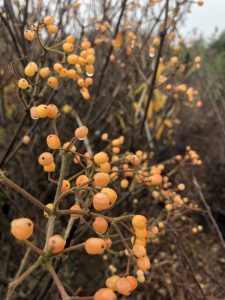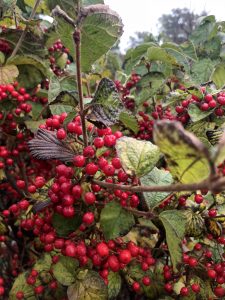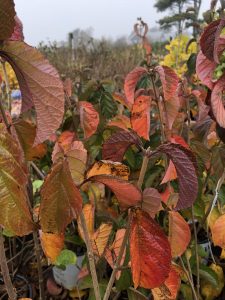Ornamental grasses are beautiful, deer-resistant and easy to grow. Although there are many lovely native grasses, the majority of ornamental varieties are introduced from Asia. We sell hundreds upon hundreds of these plants each year and their popularity seems to keep growing.
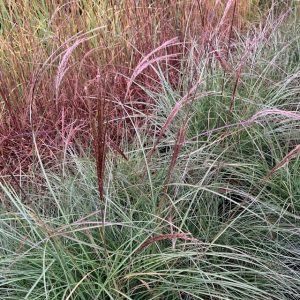 Most ornamental grasses are clumping, perennial, warm-season grasses that will come back for years. Although there are many species and varieties available, the most popular today are Maiden Grasses, Miscanthus sinensis and Fountain Grasses, Pennisetum alopecuroides. If sited in full sun and grown on average soil, these plants require little care – just cut them back to a few inches above the ground during the winter and irrigate during dry spells in the summer. Maiden grass do best if dug and divided every 5 years or so, which is a major undertaking! Make sure to keep this extra step in mind when planting them, as the clumps can get very large as they age.
Most ornamental grasses are clumping, perennial, warm-season grasses that will come back for years. Although there are many species and varieties available, the most popular today are Maiden Grasses, Miscanthus sinensis and Fountain Grasses, Pennisetum alopecuroides. If sited in full sun and grown on average soil, these plants require little care – just cut them back to a few inches above the ground during the winter and irrigate during dry spells in the summer. Maiden grass do best if dug and divided every 5 years or so, which is a major undertaking! Make sure to keep this extra step in mind when planting them, as the clumps can get very large as they age.
The most popular grasses are listed below:
Miscanthus sinensis ‘Gracillimus’: Gracillimus Maiden Grass. The most common large ornamental grass sold. Broad, vase shaped form, reaching 6′ tall. Deep-green, finely textured blades have a narrow white mid-rib. Silver/buff-colored flowers appear above the foliage in late summer and persist into the winter. After a number of years, the clumps will spread to 3+ feet wide, with the foliage spreading out to at least 5 feet. The dense crown of the plant may die out in the center, signaling that it’s time to divide. Division is best done in late spring, just as new growth has begun to emerge.
Miscanthus sinensis ‘Adagio’: Adagio Maiden Grass. Another large grass, similar to ‘Gracillimus’, but a foot or two smaller in size overall.
Pennisetum alopecuroides ‘Hameln’: Dwarf Fountain Grass. Rounded grass with a cascading habit, 2 – 2.5′ tall and wide. Mid-green foliage changes to yellow in fall. Fluffy, bottle brush-shaped flowers appear in mid August above the foliage on narrow stems.
Panicum virgatum, cvs.: Switch Grass. Many varieties of this native grass are now in commerce. Generally, upright 3-5′ tall. Airy inflorescences appear in mid-summer. Breeding in these grasses has focused on improved form and foliage color. ‘Heavy Metal’, an old favorite, has a metallic blue sheen to the leaves and average height of 5′. For a more compact variety, try ‘Cape Breeze’ a dwarf that stays about 2.5′ tall. Many other cultivars are available with purple or blue foliage, some reaching 8′, making a major statement. For more information on switch grass check out: https://surfinghydrangea.com/switch-grass-2086
Nassella tenuissima aka Stipa tenuissima: Mexican Feather Grass. One of the few cool-season ornamental grasses, this plant has gained in popularity in recent years, especially used as a mass planting. The light green, fine-textured foliage emerges in late spring. This fresh growth appears upright early in the growing season, but becomes more arching as it elongates to 1-2′ in height, with a more fountain-like habit. In mid-summer the airy inflorescences emerge and the foliage changes to a beachy, buff-tan.
These are only a handful of the grasses that we stock. On any given day, we will have many more to choose from. We’d be happy to show them to you.

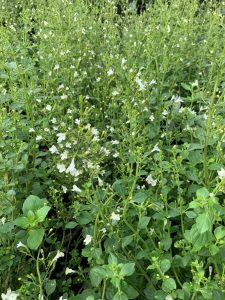 Nearly every gardener that has visited the nursery this year has spoken about the uptick in rabbit and deer damage this year. The rabbits are ravenous and the deer are nearly impossible to keep out, short of installing a professional farm-grade border fence. These animals have become more than an nuisance – they are a serious problem. Year after year, the list of plants deer and rabbits won’t destroy has gotten much shorter. Russian sage, catmint, lavender and grasses are still mostly reliable (although we had a whole crop of catmint eaten early this spring). Another favorite of ours is calamint, Calamintha nepetoides cvs.
Nearly every gardener that has visited the nursery this year has spoken about the uptick in rabbit and deer damage this year. The rabbits are ravenous and the deer are nearly impossible to keep out, short of installing a professional farm-grade border fence. These animals have become more than an nuisance – they are a serious problem. Year after year, the list of plants deer and rabbits won’t destroy has gotten much shorter. Russian sage, catmint, lavender and grasses are still mostly reliable (although we had a whole crop of catmint eaten early this spring). Another favorite of ours is calamint, Calamintha nepetoides cvs. 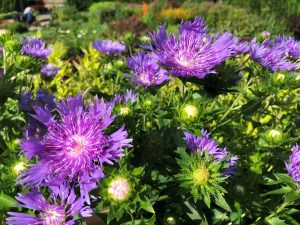
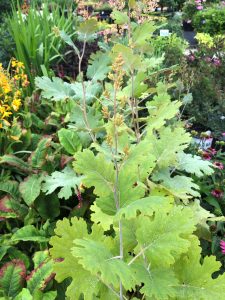 At Surfing Hydrangea, we sell a wide variety of “bread and butter” plant material that landscapers are looking for every day, like cherry trees, catmint and fountain grasses. Keeping lots of stock of those items is great for business, but it’s always the plants that I’ve never heard of, or seen in person that get me jazzed up for gardening again when I’m a little burned out. My favorites are often the new introductions and hard-to-find perennial treasures that Britt brings in for the courtyard.
At Surfing Hydrangea, we sell a wide variety of “bread and butter” plant material that landscapers are looking for every day, like cherry trees, catmint and fountain grasses. Keeping lots of stock of those items is great for business, but it’s always the plants that I’ve never heard of, or seen in person that get me jazzed up for gardening again when I’m a little burned out. My favorites are often the new introductions and hard-to-find perennial treasures that Britt brings in for the courtyard.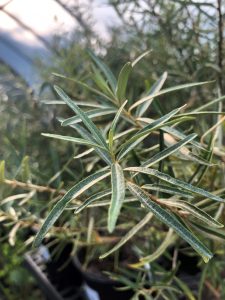
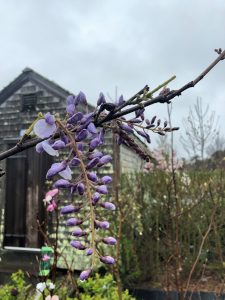 I’ve spent many, many hours on ladders and on top of roofs and pergolas as a professional gardener on Nantucket. The bulk of those hours have been spent on rose care, but pruning and training wisteria is actually one of my all-time favorite garden tasks. This graceful, spring-flowering vine requires a lot of work to keep in bounds and looking its best. This is especially true of the Asian varieties, which are quite a bit more rampant than their North American cousins. Although there are many cultivars and hybrids, Asian wisteria can generally be separated into to groups: Japanese and Chinese.
I’ve spent many, many hours on ladders and on top of roofs and pergolas as a professional gardener on Nantucket. The bulk of those hours have been spent on rose care, but pruning and training wisteria is actually one of my all-time favorite garden tasks. This graceful, spring-flowering vine requires a lot of work to keep in bounds and looking its best. This is especially true of the Asian varieties, which are quite a bit more rampant than their North American cousins. Although there are many cultivars and hybrids, Asian wisteria can generally be separated into to groups: Japanese and Chinese.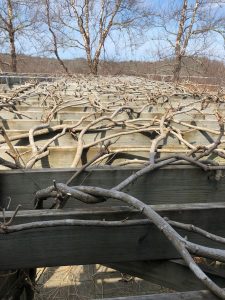
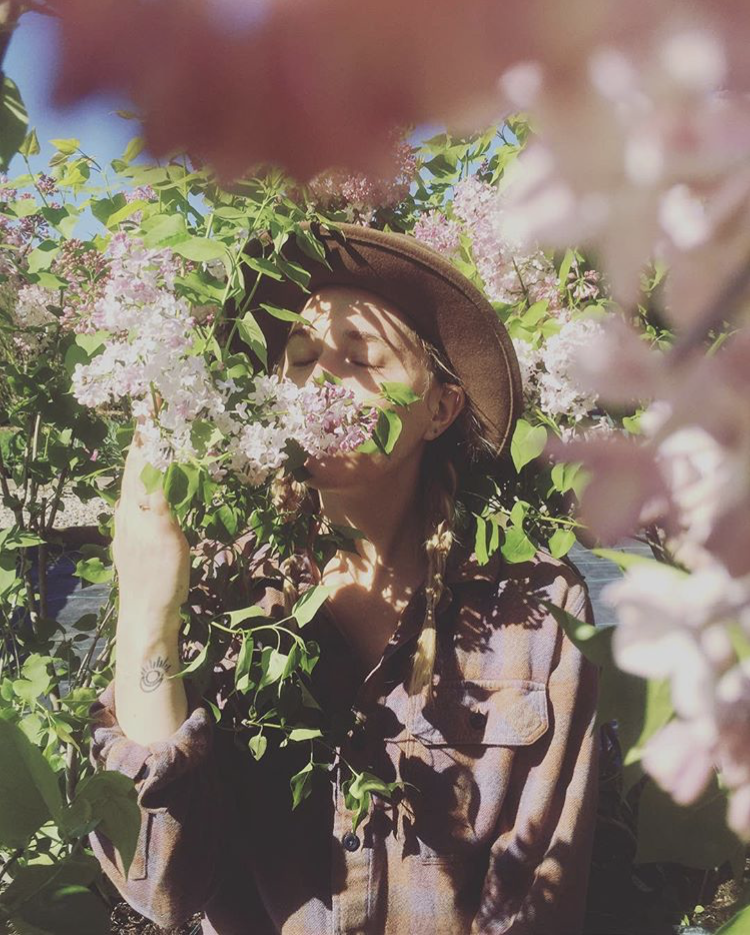
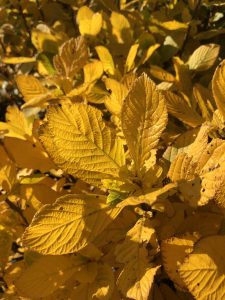 Clethra alnifolia, as botanists refer to it, is a native North American plant that is endemic to Nantucket where it can be found growing in low-lying areas and at the edges of wetlands. If grown in moist soil, it tends to sucker and form colonies over time. However, this plant is well-behaved and very adaptable, doing well in most any island garden where average soil and even water is available. It prefers full sun, but will flower in shade. The overall look of these plants is a pleasant green, twiggy shrub with an upright, balloon-shaped habit. They have medium green, rounded, ovate leaves with finely-toothed edges. In mid summer, they produce loads of fragrant flowers that are reminiscent of small, skinny bottle brushes. The native form of this plant generally has white flowers, but there are pink cultivars available, as well. Beneficial insects like it just as much as we do; many species of butterflies, bees, wasps, flies and other flying insects frequent the plant while it is in flower during July and August.
Clethra alnifolia, as botanists refer to it, is a native North American plant that is endemic to Nantucket where it can be found growing in low-lying areas and at the edges of wetlands. If grown in moist soil, it tends to sucker and form colonies over time. However, this plant is well-behaved and very adaptable, doing well in most any island garden where average soil and even water is available. It prefers full sun, but will flower in shade. The overall look of these plants is a pleasant green, twiggy shrub with an upright, balloon-shaped habit. They have medium green, rounded, ovate leaves with finely-toothed edges. In mid summer, they produce loads of fragrant flowers that are reminiscent of small, skinny bottle brushes. The native form of this plant generally has white flowers, but there are pink cultivars available, as well. Beneficial insects like it just as much as we do; many species of butterflies, bees, wasps, flies and other flying insects frequent the plant while it is in flower during July and August.